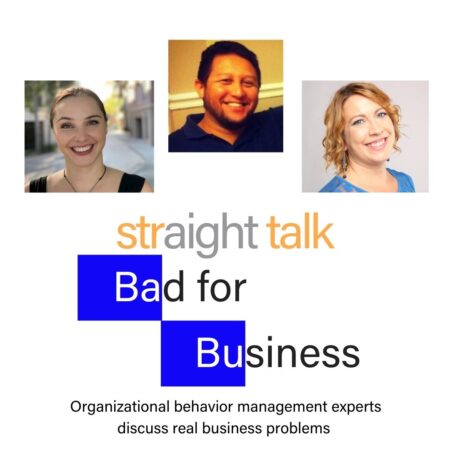As diversity and inclusion experts, we are often asked to conduct cultural assessments to determine the level of diversity and inclusion within an organization. One of the questions we often ask is for participants to describe their organizational culture in one sentence. This question is often difficult for participants to answer. They either are not clear on the definition of organizational culture, or the culture is too chaotic, cliquish, and disrupted. More often than not it is the latter.
Why are so many companies struggling to create a positive work culture?
The answer is simple: Those in leadership positions are not trained to be inclusive leaders.
The solution to change company culture is a bit more difficult. The culture of an organization drives the way employees feel when they come to work and the way they do their work, work on teams, and interact with one another, and ultimately, the quality and efficiency of their work. It is the result of all of the values and priorities that drive behavior.
The reason it is so important is that it affects the motivation of employees. Those who work in an organization with a positive culture are motivated to work hard, perform well, and continue coming to work. However, those working in an organization without positive culture are less motivated to work, less likely to stay, and more likely to be less productive. If you are not motivated to improve your company’s culture for any other reason, hopefully understanding that your business will do better when your company’s culture is positive will be motivation enough.
However, while creating workplaces where employees are excited to come and motivated to perform well seems like a no brainer, many companies struggle when it comes to changing their culture for the better. The question then becomes, how do you change company culture?
The answer: It starts with inclusion.
Typically when I begin talking with leaders about inclusive leadership, they think about how to diversify their staff. While this is certainly important, you cannot simply add new groups of individuals to the workforce and think they will somehow change your company culture. The opposite is true. New employees will feel pressure to become a part of the existing culture, and if it is not inviting to them, they will likely end up leaving.
Inclusion is not about the differences between the individuals in your workforce. Inclusion is about how you treat each and every individual who is a part of your organization. Inclusion focuses on the employee’s experience and whether or not they show up to work feeling as though they belong and have a clear purpose for their work that is tied to the organization’s vision and goals. However, creating inclusive cultures is not easy work. If it were, every organization would have mastered it by now.
That said, there are some strategies that leaders can implement to be more inclusive.
Create a strong vision, mission, and values for the organization or your team.
Depending on your level in the organization, you may not be able to change or alter the overarching vision, mission, and values. However, you can create these for your team, as long as you ensure they are aligned with the overall organization. In fact, doing this will motivate your team even more, as it shows clear purpose for your specific team and helps illustrate each individual’s necessary role in reaching that vision.
First, start with the values. This is best completed as a group exercise where you first ask your staff to brainstorm what values are most important to them in their position and as part of the team. Once you have an exhaustive list, allow each member to have 3-5 votes to narrow the list down to 3-5 values.
After this, create your vision, which should be forward looking, highly motivational, and focused on the larger purpose of your team or organization. For example, Pepsico’s vision is to “be the global leader in convenient foods and beverages by winning with purpose”. Their vision gives their employees purpose and differentiates them from other similar companies. Your vision should do the same, whether you are creating one for the organization or the team.
Finally, create your mission, which states how you will reach your vision. Pepsico’s mission is to “create more smiles with every sip and every bite.” They make it clear that the way they will become the global leader in convenient foods is to create smiles when people consume their products.
Once these are created, take it one step further and tie every position in the organization or on your team to the vision and mission. Make the purpose of each and every individual clear. This will help motivate your employees to perform, as they now know how each task is tied to the greater vision and mission.
Provide consistent and positive feedback.
Everyone wants to know whether or not they are doing a good job. Unfortunately, the majority of American workers only know they are doing a good job when they are not getting yelled at. The problem with this is that it creates “just enough” responding. Employees who perform to avoid getting in trouble only do enough to avoid that trouble. They rarely go above and beyond. And, instead of focusing on doing their best, they are instead focused on how not to screw up.
The best way to increase work production is to tell people what they are doing right. Employees should know consistently that they are performing well, not because they are not getting yelled at, but because their leaders are telling them “good job”, “thank you”, and “nice work on that”. If you really want to go the distance, tell employees exactly what they did that is right. For example, “it’s really helpful for me that you always turn in your weekly reports on time” or “The care you put into the truck checks each week is outstanding. I always have confidence that everyone will be safe thanks to your attention to detail.”
If you are not in the habit of providing consistent positive feedback, start today.
Ensure policies and procedures are followed by everyone consistently.
One of the biggest problems in non-inclusive environments is the differential application of policies and procedures to staff. While sometimes this is intentional, more often leaders find themselves not following policies and procedures consistently because they are avoiding difficult conversations, they are unsure of the practices to be followed, or because there are not clear policies to follow and they don’t remember what they did before. No matter the reason, when policies and procedures are not consistently followed, staff report leaders have favorites or single people out on purpose. Accusations of bullying, unfair treatment, and cliques usually occur in these situations.
To remedy this, leaders must ensure policies and procedures and clear and followed at all times. Staff who are not following policies and procedures should be corrected and retrained immediately. Conversely, those who are following them correctly should be praised. If inclusion is a priority in your organization, the best first step is to determine the consistency of practices.
Inclusive practices result in organizations that are inviting to all.




